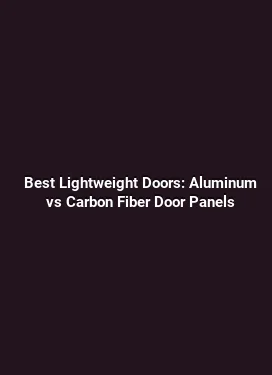How to Install Wide Body Kit on Nissan 240SX Complete Fender Flares
Achieving a bold, aggressive stance on a Nissan 240SX often starts with a wide body kit paired with complete fender flares. This guide delves into the practical aspects of selecting, planning, and installing a full set of fender flares while maximizing aerodynamics, fitment, and durability. Emphasis is placed on real-world steps, torque specs, weather sealing, and long-term maintenance to ensure a robust install that remains visually striking and structurally sound through daily driving and spirited track sessions alike.
Understanding the purpose and benefits of a wide body kit for the 240SX

A wide body kit modifies the overall perception and geometry of the vehicle by extending the fender lines outward. This creates room for wider wheels and tires, which improves traction and cornering grip while allowing for more aggressive brake setup clearance. Beyond aesthetics, properly integrated fender flares can reduce turbulent air around the wheel arches and help manage airflow across the front and rear fenders. The result is a cohesive silhouette that complements performance goals without compromising daily usability.
When selecting a complete fender flare set, it is important to distinguish between bolt-on, riveted, and welded installations. Bolt-on kits are typically the easiest to install and remove, making them a popular choice for street-driven cars. Riveted and welded options can offer enhanced rigidity and a cleaner finished look, but require more extensive fabrication and bodywork. Each method has its trade-offs in terms of weight, ease of maintenance, and potential impact on resale value.
Key components of Fender Flares and their role in the installation
Fender flares come as a collection of components that work together to bridge the wheel opening and the extended outer surface. The core elements include the flare itself, mounting hardware (rivets, screws, or bolts), a rocker or edge trim to seal the junction with the body, and often a sealing gasket to keep moisture and debris out of the fender cavity. Some kits include a weather-resistant sealant or seam sealer that remains flexible under temperature fluctuations and vibration.
Understanding the fitment is crucial. A properly designed flare will align with the existing body lines, leaving an even gap along the wheel arch. The attachment points should follow solid structural areas of the sheet metal or the chassis where possible. In some cases, minor trimming to the fender edge or the inner wheel well liner is required to ensure a clean contour and adequate clearance for tire movement. When dealing with fiberglass or composite flares, check for surface imperfections and plan for a light sanding to ensure a uniform bond or paint finish.
Preparing for a precise fitment: measurement and mock-up

Before any drilling or permanent attachment, create a mock-up to verify alignment. Use painter’s tape to map the flare edges against the body panels. Gently push the flare outward to assess the true gap at the top, middle, and bottom sections of the wheel arch. Pay special attention to the curvature at the corners and along the rocker panel. For wider setups, wheel alignment and tire size choices influence clearance; ensure there is enough room not only for the tire but for suspension travel as the car compresses under load.
A practical tip is to place temporary shims or washers at the attach points to simulate the final spacing. This helps anticipate any gaps that may require trimming or reshaping, and it reduces the risk of misaligned holes during the actual mounting process.
Planning and preparation: measuring, tools, and safety
Successful installation starts long before the first drill bit turns. Gather the necessary tools: a drill with metal bit assortment, a stable drill guide, a pop rivet gun or mechanical fasteners compatible with the chosen kit, panel adhesive or sealant suitable for automotive exterior applications, and a torque wrench for precise fastener tightening. A heat gun or sanding block can aid in shaping edges to fit the curvature of the 240SX’s fender lips. Safety follows suit—protect the paint, wear eye protection, and work in a clean, well-lit area to avoid missteps that could mar the bodywork.
Layout and fitment planning involves confirming wheel and tire dimensions. For example, a common upgrade path uses wheels with a 4- to 6-inch offset with a tire width ranging from 235 mm to 275 mm, depending on the flare width and desired stance. Ensure the final tires do not rub the fenders during full steering lock or during compression over uneven pavement. If you plan to lower the car, you may need to adjust the flare height and trimming to prevent tire contact under compression.
Choosing the right Fender Flares for the 240SX: materials, style, and compatibility
Fender flares come in several material options, including ABS plastic, fiberglass, and aluminum composites. Each material offers distinct advantages. ABS plastic is typically lighter and easier to install for bolt-on systems, while fiberglass provides a more OEM-like feel and can be shaped for a precise contour with more advanced bodywork. Aluminum options tend to offer greater durability and a premium finish, but they can be more challenging to work with for beginners.
Style considerations influence not only aesthetics but also aerodynamics. For the Nissan 240SX, a wide body kit should harmonize with the car’s lines: a low, wide stance with a clean transition between the fender and the side skirt. Some kits include a matching rear spoiler or a front spoiler lip to further unify airflow characteristics. It is beneficial to study current builds with similar geometry to gauge how the kit interacts with the vehicle at speed, especially at highway velocities where aero performance becomes more noticeable.
Fabrication notes for a seamless finish
After verifying fitment, consider trimming the inner wheel well to accommodate the flare’s contour and to prevent rubbing on full suspension travel. When washers or spacers are used for alignment, ensure they are corrosion-resistant and properly seated to avoid loosening with vibration. For fiberglass flares, it is common to apply a light coat of spray-on primer to the edges to reduce moisture absorption and keep the seam area uniform for painting.
Installation process: Step-by-step guide for a secure and durable fit
The following steps outline a practical approach to installing complete fender flares on a Nissan 240SX. The emphasis is on methodical progress, quality fasteners, and reliable sealing to withstand road debris and weather exposure.
Step 1: Surface preparation and masking
Begin with a thorough cleaning of the fender area and surrounding panels. Remove dirt, wax, and any old sealants from the edge where the flare contacts the body. Mask the adjacent surfaces with painter’s tape to prevent accidental scratches during drilling and fastening. If the fender edges show sharp burrs after trimming, carefully deburr them to avoid paint cracking later on.
Inspect the flare’s underside to ensure it does not contact any critical components such as brake lines or ABS sensors. In some builds, you may need to relocate or resize inner liners to maintain clearance without compromising structural safety.
Step 2: Temporary positioning and alignment
With the car supported on a stable stand or jack stands, begin with one side. Hold the flare against the wheel arch and secure it loosely with a few temporary fasteners or clamps. Check key alignment landmarks: the top edge should mirror the body line, and the flare’s bottom should sit just above the rocker panel. Use a straight edge or laser level to verify a consistent line along the entire length of the flare.
Address any gaps by adjusting the flare position or performing light trimming on the inner lip. The objective is to create an evenly spaced gap that will guide the final fastening pattern. Repeat the process on the opposite side to achieve symmetrical fitment before final tightening.
Step 3: Attachment method selection and execution
Choose the appropriate attachment method based on your kit and goals. Bolt-on systems are straightforward: drill aligned holes and insert OEM-style bolts with washers, then snug to a consistent torque. Rivet-based systems require precise hole positioning and a rivet gun; use blind rivets designed for outdoor automotive use to handle vibration and temperature changes. If the kit uses adhesive backing, apply a continuous bead of seam sealer at the contact edge to improve water resistance and reduce flex at speed.
As you progress, periodically check the alignment to ensure nothing shifts during fastening. For rigidity, apply a light layer of sealant along the inner edge where the flare meets the body to seal the joint against moisture intrusion. Allow any adhesive or sealant to cure according to the manufacturer’s recommendations before driving the vehicle aggressively.
Step 4: Finishing and detailing
After all fasteners are secure, inspect each joint for uniform spacing and tightness. Wipe away excess sealant and perform a final check for any protruding hardware that might interfere with wheel movement or contact the suspension. If the kit requires trimming for a precise fit, use a sanding block and fine grit paper to achieve a smooth transition that accepts paint evenly. Apply a primer and topcoat initiated by the rest of the body color to ensure a durable, weather-resistant surface that resists chipping and UV degradation.
For those focusing on aesthetics, consider painting the flare interiors the same color as the body or opting for a contrasting shade to accentuate the wheel arches. A clear protective coat can help preserve the finish against everyday road hazards like stone chips and salt in winter conditions.
Maintenance and care for a wide body setup
Maintaining the integrity of wide body flares requires routine inspection. Periodically check for loose fasteners, cracks in fiberglass or seams in adhesive joints, and any signs of paint chipping near the attachment points. If you operate the car in harsh climates, inspect for corrosion around metal fasteners and consider applying anti-corrosion treatments.
Winter storage or long-term parking can lead to paint oxidation and edge wear. Regular washing and waxing of the flare area help preserve the finish, while a soft brush removes accumulated debris from gaps that can trap moisture. If you ever need to remove the flares for service work, ensure that you document the original alignment markers so reinstallation preserves the intended fitment geometry.
Practical considerations: daily driving, track use, and legality
Wide body kits must balance form and function. For daily driving, verify that the flare does not create excessive glare in mirrors or interfere with a passenger’s door opening range. Track-focused builds should prioritize consistent alignment and robust sealing to handle high-speed air pressure, which can stress adhesive seams over time. Local regulations may specify minimum clearance requirements and bump-stop considerations; even a well-fitted kit can be non-compliant in certain jurisdictions if it encroaches on wheel travel or protrudes beyond the body line excessively.
Understand that some manufacturers provide region-specific guidelines or warranty coverage that may influence your installation choices. Reading the kit’s documentation thoroughly helps avoid warranty complications and ensures the installed flares perform as intended under both normal and extreme conditions.
Advanced integration: aerodynamics, clearance, and performance tuning
Beyond aesthetics, a wide body kit can influence the車 aerodynamic profile of the 240SX. While the main objective is wheel and tire clearance, a well-designed flare can smooth the transition from body panel to flare to minimize drag-inducing eddies. In some setups, the addition of a front lip, side skirts, and a rear diffuser can further optimize air flow around the wheel wells. When aligning these components, consider the overall ride height, bumper geometry, and the underbody airflow characteristics to maintain a balanced aero package that reduces lift while preserving stability at speed.
On a practical level, verify that all wiring, sensors, and brake lines remain accessible. If a kit requires trimming near critical components, plan for protective sleeves or routing changes to prevent chafing and heat damage. Finally, ensure the finish remains robust against UV exposure and road salts by selecting paints and sealants that are rated for automotive exterior use and compatible with the chosen flare material.
Car care and finishing touches
After completing installation, perform a road test in a controlled environment. Listen for unusual creaks or rattles that could indicate a loose fastener or misaligned edge. A careful drive around varied surfaces helps confirm there is no contact with suspension components or brake ducts during full range of motion. When you return to the workshop, re-check torque specs and refine any gaps for an even, polished appearance that complements the vehicle’s stance.






